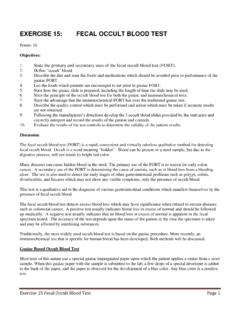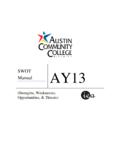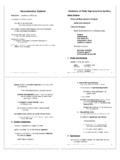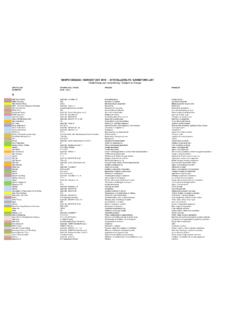Transcription of Phylum Chordata - Vertebrata Mammals
1 Phylum Chordata - Vertebrata Mammals relatively small group 5,100 species ~half # of birds; ~1/5th # of fish species today, is one of most successful group of vertebrates Cenozoic = age of Mammals occupy every major habitat on earth most massive of all animals today or that ever existed blue whale 105', to 150 tons blue whale, Balaenoptera musculus, Mature blue whales typically measure anywhere from 75. feet (23 m) to 100 feet ( m) from head to tail and can weigh as much as 150 tons (136 metric tons). The largest blue whale on record is a 110' female that weighed 195 tons (177 tonnes). their bulk is several times greater than the largest dinosaur elephants are largest land mammal Animals: Phylum Chordata - Vertebrata ; Mammals ; Ziser Lecture Notes, 1. 11' tall, 14,500 lbs (=6,590 kg). smallest Mammals : pygmy shrew ~ (4 cm, few grams). Kitti hognosed bat oz ( g). Mammals are also the vertebrate group most affected by human activities: domestication food clothing beasts of burden pets research education hunting alien animals pleistocene extinctions modern extinctions Animals: Phylum Chordata - Vertebrata ; Mammals ; Ziser Lecture Notes, 2.
2 Origin of Mammals Mammals developed from mammal-like reptiles (therapsids; from synapsids) ~200 MY ago mammal-like reptiles share many skeletal features with Mammals legs held closer to body not splayed out as in most reptiles faster more agile decreased stability due to new gait lead to increased development of cerebellum for muscle coordination secondary palate separates nasal and mouth cavities teeth differentiated into incisors, canines, cheek teeth many reptiles had hair (none today do). some were warm blooded but: Mammals have lower jaw consisting of a single bone with articulation between jaw and squamosal bone mammal-like reptiles lack this articulation Mammals first appeared 200 MY ago Animals: Phylum Chordata - Vertebrata ; Mammals ; Ziser Lecture Notes, 3. early Mesozoic (same time as 1st dinosaurs). 1st mammal: very closely resembled their reptile ancestors about size of mouse (or ground shrew).
3 Reptilian skeleton had sharp teeth ate insects, worms, fruits, vegetables large eyes probably nocturnal warm blooded (many reptiles were warm blooded then). for 160 MY they lived in the shadow of the dinosaurs most were small, shrew-like animals, largest were 3'. long. suddenly the dinosaurs disappeared ~65 MY ago when dinosaurs vanished near beginning of Cenozoic Mammals diversity greatly increased the first modern (placental) Mammals appeared and diversified the most successful group, placental Mammals , originated and diversified Mammals were now agile, more intelligent, warm blooded, well insulated, and suckled their young moved into habitats vacated by dinosaurs and became the dominant large animals on land and in sea Animals: Phylum Chordata - Vertebrata ; Mammals ; Ziser Lecture Notes, 4. Dawn of Cenozoic = age of Mammals . may have been 2 separate lines of mammal origin & evolution: prototheria egg laying Mammals ; poor thermoregulation theria all others Animals: Phylum Chordata - Vertebrata ; Mammals ; Ziser Lecture Notes, 5.
4 Skin & Derivatives skin is thicker and more complex than in other vertebrate groups (or any other animal). thicker layers esp dermis (hide=leather). many different glands sensory structures hair a. Hair hair (fur) replaced scales as main covering for better insulation some facial hairs (=vibrissae) became sensory in function today, especially characteristic of Mammals in past, some reptiles had fur and/or feathers grows from follicle in epidermis and dermis cells at base of follicle produce hair when it reaches a certain length,it stops growing made of keratin (protein). same as nails, claws, hooves, feathers of birds and scales of reptiles and birds Animals: Phylum Chordata - Vertebrata ; Mammals ; Ziser Lecture Notes, 6. most Mammals have two kinds of hair: underhair dense and soft for insulation traps layers of insulating air in aquatic Mammals (fur seal, otter, beaver). its almost impossible to wet skin guard hair coarse and long protection against wear coloration some also have hair modifications: a.
5 Defensive hairs eg. porcupines, hedgehogs b. horny or bony plates eg. armadillo, pangolins c. some have lost most of their fur eg. hippos, elephants, porpois, humans shedding (molting). in most Mammals entire coat is periodically Animals: Phylum Chordata - Vertebrata ; Mammals ; Ziser Lecture Notes, 7. molted eg. foxes and seals 1x/yr eg. most Mammals have 2 annual molts spring replaced by thinner hairs fall replaced by thicker hairs in humans hair is shed and replaced continuously throughout life coloration of hair: camoflage protective camoflage: eg. arctic white eg. outside arctic somber colors disruptive camoflage eg. leopard spots eg. tiger stripes eg. fawn spots warning eg. skunk modified hairs: bristles of hogs spines of porcupines Animals: Phylum Chordata - Vertebrata ; Mammals ; Ziser Lecture Notes, 8. vibrissae (whiskers) tactile, sensory hairs b. horns and antlers: horns or antlers are found in only 5 families of ungulates: Rhinoceri cattle, sheep, goats, etc pronghorns moose, caribou, elk, deer [virtually all even toed ungulates with ruminant (4- chambered) stomachs have horns or antlers].
6 1. horns esp cattle, sheep, goats, rhinos, etc unbranched horns originated early, >100M yrs ago, in large reptiles hollow sheaths of keratinized epidermis (same as hair, scales, feathers, claws, nails, hooves). surrounds bony core grow continuously throughout life not normally shed; do not regenerate of cut off usually used as a weapon for protection eg. only pronghorn seasonally sheds its horns eg. rhino horn has been collected for >1000 yrs Animals: Phylum Chordata - Vertebrata ; Mammals ; Ziser Lecture Notes, 9. 2. antlers esp deer, caribou, moose, elk antlers originated in Mammals ~50M years after horns entirely bone, no keratinized layer covering it tend to be large complex and ornate used mainly for sexual display during mating season sometimes require a significant investment in resources to grow them (esp. large amounts of minerals). eg. moose or elk need 50lbs of Calcium/season to grow them eg.
7 Antlers of irish elk weighed more than the rest of its skeleton; 3 M across, 154 lbs living tissue; sensitive to touch and pain develop beneath highly vascularized sheath= velvet velvet dropped off after breeding season 3. Giraff Horns antler-like but retain skin covering; are not shed c. Glands Mammals have a great variety of skin glands the glands confer some of the most important mammalian traits Animals: Phylum Chordata - Vertebrata ; Mammals ; Ziser Lecture Notes, 10. 1. sweat glands (ecrine glands). important in warmbloodedness; temperature control esp on hairless regions; eg foot pads simple, tubular, highly coiled only Mammals have sweat glands heat regulation part excretory organ 2. scent glands & apocrine glands smell important in most mammal social behaviors almost all Mammals , inc humans their location and function vary greatly used for communication: territory warning defense mating 3.
8 Oil (sebaceous) glands associated with hair follicles used to keep skin and hair pliable and waterproof 4. mammary glands parental care; secrete milk all Mammals feed their young milk all females; rudimentary in males probably modified sweat glands in all female Mammals rudimentary in males Skeleton & Support Animals: Phylum Chordata - Vertebrata ; Mammals ; Ziser Lecture Notes, 11. each species of mammal has a typical adult size skeleton doesn't keep growing throughout life as in amphibians and reptiles 4 limbs for locomotion (=tetrapods). pectoral & pelvic appendages most have fore and hind limbs similar limbs are up under the body not sprawled out to the sides much more efficient movement than other land animals many Mammals walk more on their toes greater speed for both predators and prey often smaller Mammals can move at same speed as larger Mammals eg. horse vs greyhound (but larger need more powerful limbs and muscles).
9 Predators tend to have retractable claws Muscles & Movement Animals: Phylum Chordata - Vertebrata ; Mammals ; Ziser Lecture Notes, 12. Mammals display a wide variety of movements other than walking and running typically require modifications of bones of the appendages hopping provides sudden bursts of speed and quick changes of direction at high speeds, the metabolic act of hopping is much lower than that of running on all 4's eg kangaroo brachiation tree life arms longer than legs eg. primates burrowing limbs are short and powerful eg. badgers, marmots, moles have very large ears to pick up sounds flying only bats moved into niche largely unoccupied by birds night flying Animals: Phylum Chordata - Vertebrata ; Mammals ; Ziser Lecture Notes, 13. for wing, skin is stretched between elongated fingers and attached to legs and tail beats up to 20x's/second use echolocation to avoid objects and find prey emit high frequency sound waves that bounce off objects and return can detect distance from objects bats generally have large ears to pick up sound a few bats don't use echolocation large eyes & good sense of smell feed on fruits & nectar some bats migrate up to 500 miles annually gliding generally nocturnal can travel 40-50 M at a time flying squirrels, some marsupials, lemurs Feeding and Digestion Mammals are warmblooded and much more active than reptiles Animals: Phylum Chordata - Vertebrata ; Mammals ; Ziser Lecture Notes, 14.
10 Require 10-13 x's the food energy as living reptiles and amphibians to maintain the same body mass teeth all but a few Mammals have teeth eg. monotremes, anteaters, some whales earliest Mammals were insectivores teeth were all the same peglike shape today, teeth represent the greatest evolutionary diversification of the mammalian skeleton teeth more than any other physical characteristic reveal the life habit of a mammal all major mammal groups can be identified from a single molar often even to species Mammals typically have 2 sets; milk teeth &. permanent teeth most other vertebrates continuously replace teeth as needed and their teeth continue to grow throughout life rather than all teeth in the mouth being the same, Mammals developed 4 major kinds of teeth incisors snipping and biting canines piercing and holding Animals: Phylum Chordata - Vertebrata ; Mammals ; Ziser Lecture Notes, 15.















